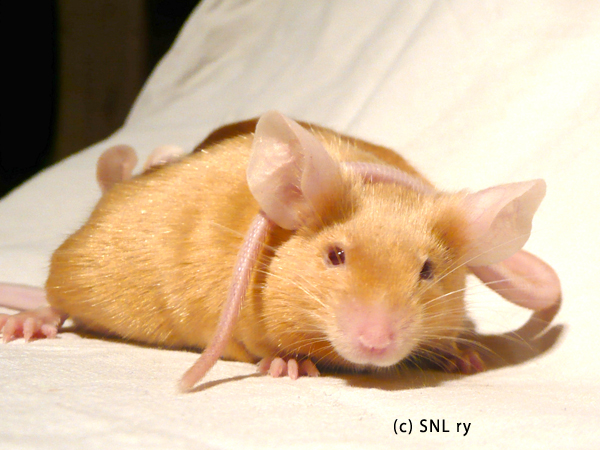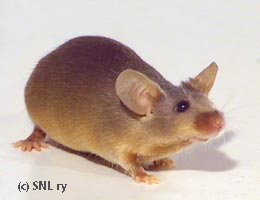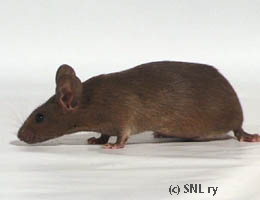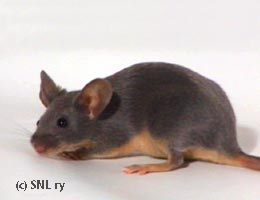Genetics
D-locus
D Locus
D-series, or black/blue locus.
D-locus
D-series, or the black / blue locus. This series is similar to the B-series, in that there are normally only two alleles present - the full colour D and the dilute d. The blue dilution d affects yellow, black and brown pigment and gives rise to other colours I have mentioned but not dealt with in any detail.
1. Full colour D
The full colour D is dominant over d, so there is no difference between the phenotype of D/D or D/d mice.
2. Blue dilution d
This dilution affects, as said, all three basic colours in the hairs of the mouse. It dilutes the yellow pigment to approximately half its depth, black pigment into slate blue colour and reduces brown pigment into "warm pinkish shade of lilac". Note, that in the USA the variety I call "lilac", the blue dilution of chocolate, is called "dove". Therefore it is best to check with your local club what name you are currently using for what variety.
2.1. d with Ay B* or bc/*
When self red mouse Ay/* B/* or bc/* has d/d instead of D/*, the colour of the mouse changes from red to buff, because of the diluting effect the d-gene has on yellow pigment. This colour is what creams used to be in the beginning of this century. According to articles in the National Mouse Club's magazine, the earliest creams were in fact lilac reds, that is Ay/* bc/* d/d. The standard required "rich Devonshire shade of cream". These mice were found in black eyed and pink eyed cream, with the pink eyed ones being more often seen in shows. However, the colour was darkish more buff than creamy. Let's call these creams here the "phase one creams". I will return to creams later on! I'll just add that these creams are called straw in Finland and are currently an unstandardized variety.
It is possible to breed blue sable mice and this variety is actually rather attractive with the blueish top shading to the tan belly. However, the belly colour is reduced by the effect of blue dilution to that of "washed out" tan - similar to the blue tans below.
2.2. d with A/* B/* and A/* bc/*
When the basic agouti has d/d - A/* B/* d/d, it becomes the blue agouti. The golden brown layer dilutes into an intermediate yellow, while the black pigment dilutes into blue. Although some people do like this combination of colours, to others it isn't simply attractive.
With A/* bc/* d/d, the colour is called either blue cinnamon or lilac agouti. Again, the golden tan colour in cinnamon is diluted, to buff / creamish colour, while the chocolate colour is diluted into lilac. The variety looks different enough from other ticked varieties to be called a true variety, but it really isn't one of the most striking ones. Furthermore, it shares the same problem lilacs do: they tend to look a tad uneven.
2.3. d with at/* B/* and at/* bc/*
Black tan at/* B/* D/D becomes the blue tan with at/* B/* d/d. The top colour is diluted into slate blue, while the tan belly gets diluted into approximately half of the depth of the black tan. This is why the blue tan never has the quality of tan the other tan (except for the lilac blue, below) varieties have. The problem with blue tans is getting as dark tan belly as possible with the blue dilution, while maintaining the correct shade on the top side.
With at/* bc/* d/d, the chocolate tan turns to lilac tan. Here, the top colour is the same shade of warm grey as mentioned already, with the tan belly being as with the blue tan. This variety is even rarer than the blue tan, probably mostly due to the poor tan colouring in the belly.
2.4. d with a/a B/* and a/a bc/*
Repetition is the mother of learning! So, the beautiful and from time to time rather popular self blue is genetically the blue dilution of the self black. Typical to the blue dilution (best seen in the self blue), is the tendency of the pigment to "clump" to the roots, with the tips of the hair being slightly lighter. This is actually a fault on the show bench, so breeders of blue are trying to eliminate this fault as much as they can. There are also plenty of shades within the blue, from rather light ones to very dark. The correct shade is slate blue, both dark enough and blue enough. The positive effect of this blue dilution is, that the unwanted tan hairs present in the black are diluted, so they don't "stand out" as well in the blue.
The blue dilution of self chocolate, the lilac, hasn't been very popular. One reason for this could be the standard, which doesn't describe the colour very well. This results with breeders forming their own opinions on the correct shade, while the judges may have completely another! Maybe this colour is best described via the more common colour - pink-eyed dilution of black, dove. The lilac is a warmer shade than dove, with the pinkish lilac shade.
2.5. d with ae
Like with the brown dilution, the blue dilution with extreme nonagouti ae is a darker shade than with nonagouti a. blues with this gene are of a lovely, correct blue shade. Furthermore, the little tan hairs there are in the normal blue are completely wiped out by the extreme nonagouti gene.






